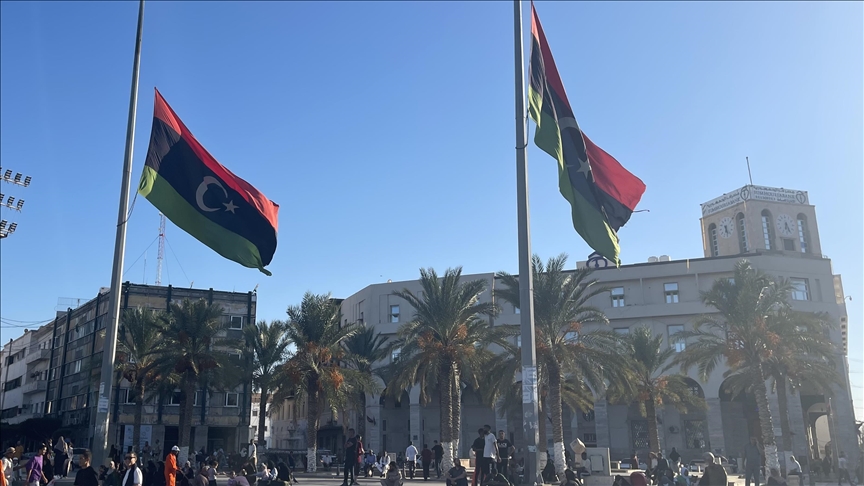Will flood disaster heal Libya’s political rift?
Flood disaster came amid years-long political rift that engulfed Libya since fall of strongman Muammar Gaddafi in 2011
 Libyan flags are lowered to half-mast, after the prime minister of Libya under the Government of National Unity Abdul Hamid al-Dbeibeh announced a 3-day mourning for those who lost their lives in the flood disaster in the country in Tripoli, Libya on September 12, 2023.
Libyan flags are lowered to half-mast, after the prime minister of Libya under the Government of National Unity Abdul Hamid al-Dbeibeh announced a 3-day mourning for those who lost their lives in the flood disaster in the country in Tripoli, Libya on September 12, 2023.
ISTANBUL
Despite years of political divisions between East and West Libya, this weekend’s floods came to reveal the depth of social and emotional interdependence in the North African nation.
At least 6,000 people were killed and thousands of others remain missing due to this weekend floods in eastern Libya, according to the latest official numbers.
The flood disaster came amid a years-long political rift that engulfed Libya since the fall of strongman Muammar Gaddafi in 2011.
The situation worsened last year when the East Libya-based parliament appointed a new government led by former Interior Minister Fathi Bashagha.
Head of Tripoli-based government Abdul Hamid Dbeibeh, however, rejected the decision, saying he will cede power only to a government that comes through an "elected parliament".
Despite the rift, rivals raced to show support to the people affected by the killer floods, with locals and organizations in West Libya sending aid to flood-stricken East Libya.
Aid convoys dispatched by the Tripoli-based government were allowed by the forces of East Libya-based commander Khalifa Haftar to cross into the country’s eastern area, according to official sources.
“The Libyans have showed unity and solidarity despite the flood disaster,” Minister of State for Communication and Political Affairs Walid Al-Lafi told a press conference in Tripoli on Thursday.
One people
Several cities in West Libya also joined efforts to send humanitarian assistance to flood-stricken Libyans in the country’s east.
A video published by government platform Hokomitna showed the arrival of electricity maintenance teams from Tripoli to the eastern city of Ajdabiya to help in efforts to restore electricity to the affected areas.
Minister of Social Affairs Wafaa Al-Kilani also said that aid convoys had arrived from Tripoli to the families affected by the floods in eastern Libya.
“We are one people and we help each other in ordeals,” Dbeibeh said in a statement.
Even rival militias raced to provide relief aid to the flood-hit areas in East Libya.
Some aid shipments were dispatched by the 444th Brigade, led by Colonel Mahmoud Hamza, and the Special Deterrence Forces of Abdul Raouf Kara in Tripoli.
The two rival militias had fought against each other a few weeks ago.
In 2019, the two militias were allies against Haftar’s forces during the warlord’s offensive on the capital Tripoli.
It was not yet clear whether Haftar’s forces allowed in the aid convoys sent by the Tripoli-based militias, but the initiative reflects that the differences between the two opponents could be resolved amid the flood tragedy.
A sticking point of differences between rival administrations in East and West Libya is the elections, which were scheduled to take place in December 2021.
In June, the 6+6 Joint Committee, formed by Libya's parliament and the Tripoli-based High Council of State, announced an agreement on laws for holding the polls.
As aid continues to flow into Libya from around the world following the deadly floods, Libyans hope that the tragedy will put an end to their political differences.
*Writing by Ikram Kouachi
Anadolu Agency website contains only a portion of the news stories offered to subscribers in the AA News Broadcasting System (HAS), and in summarized form. Please contact us for subscription options.


